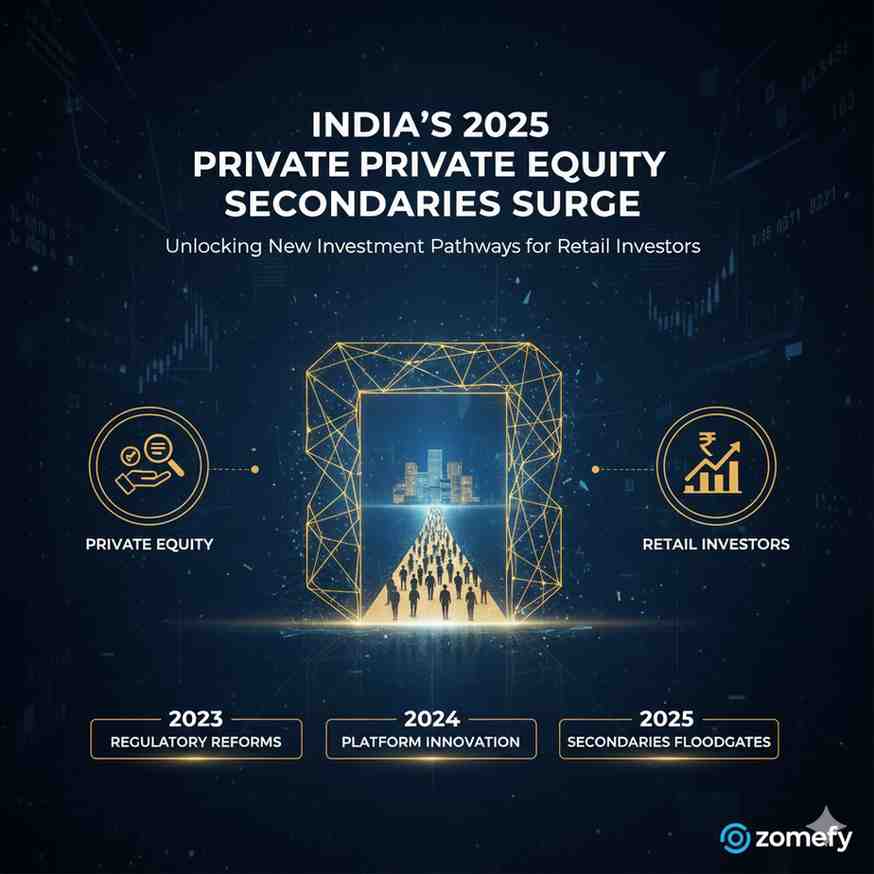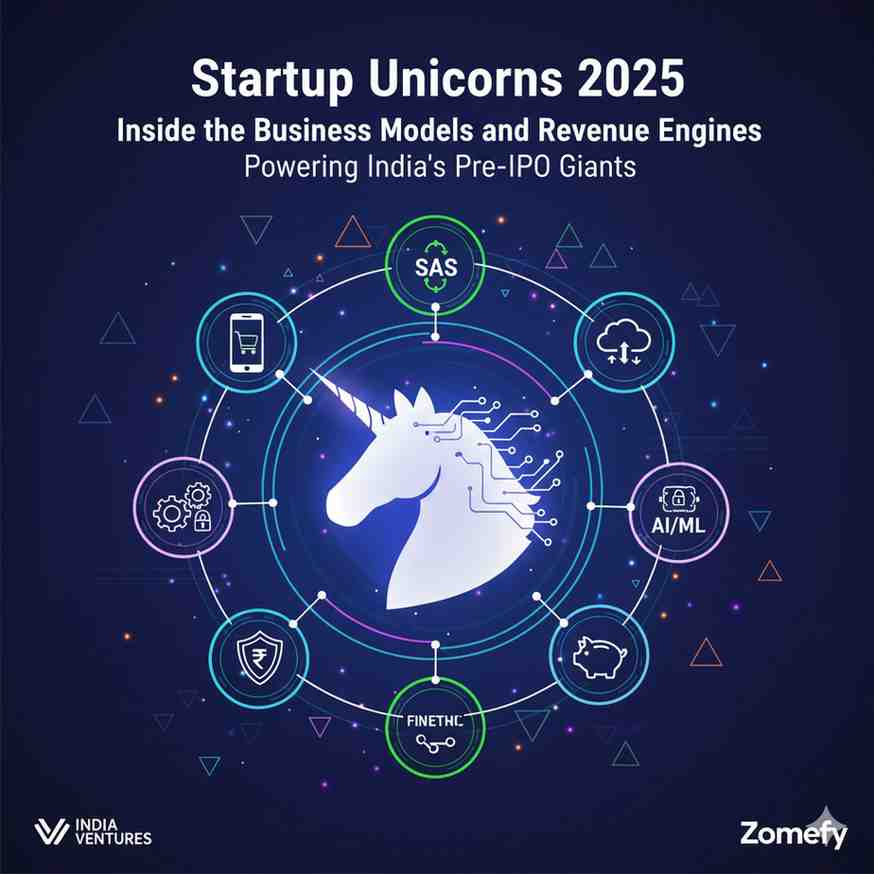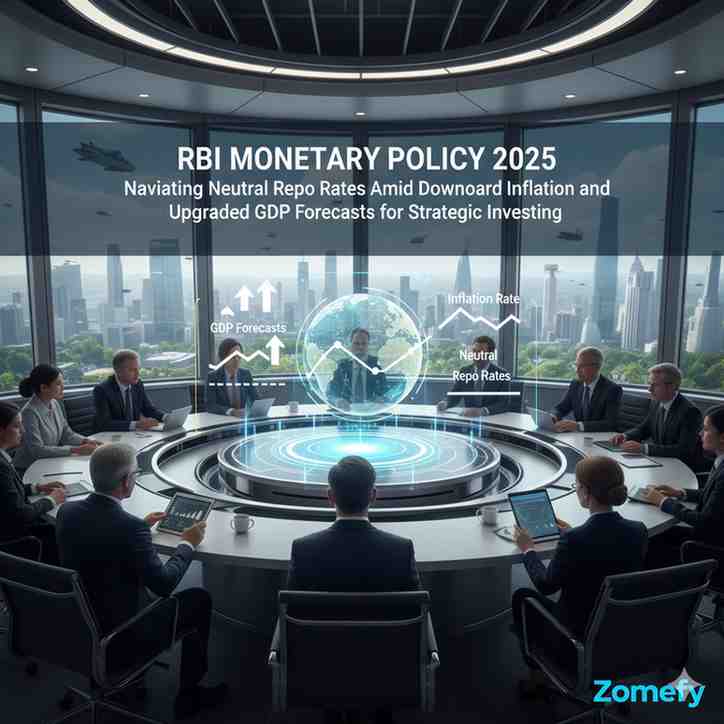RBI Monetary Policy 2025: Decoding Repo Rate Changes and Their Impact on Indian Markets and Inflation Dynamics
The Reserve Bank of India’s (RBI) monetary policy decisions, particularly changes in the repo rate, wield significant influence over the Indian economy, markets, and inflation dynamics.
RBI Monetary Policy 2025: Decoding Repo Rate Changes and Their Impact on Indian Markets and Inflation Dynamics
What You Can Do Next
- Read the full article for complete insights
- Save for later reference
- Share with others learning about this topic
Image not available
The Reserve Bank of India’s (RBI) monetary policy decisions, particularly changes in the repo rate, wield significant influence over the Indian economy, markets, and inflation dynamics. As India navigates a complex global economic environment marked by inflationary pressures, geopolitical uncertainties, and evolving domestic growth drivers, understanding the implications of RBI’s repo rate adjustments is crucial for retail investors and financial professionals alike. In 2025, the RBI has adopted a nuanced approach by adjusting the repo rate in measured steps to balance growth aspirations with inflation containment. This article decodes the recent repo rate changes, explores their impact on various sectors and asset classes, and provides actionable insights tailored to the Indian market context. We will examine historical data, sectoral performances, and key financial indicators, offering a comprehensive toolkit for investors aiming to optimize their portfolios amid evolving monetary conditions.
RBI Monetary Policy 2025: Overview of Repo Rate Changes and Economic Context
In 2025, the Reserve Bank of India (RBI) adopted a calibrated monetary policy stance, adjusting the repo rate to balance inflation control with growth support. Starting the year at 6.50% in late 2024, the repo rate was gradually reduced in phases to 5.50% by June 2025, reflecting the RBI’s dovish tilt amid easing inflation and a positive growth outlook[3][4][6]. The Monetary Policy Committee (MPC) maintained a 'neutral' stance for much of the year but shifted briefly to an 'accommodative' stance in April 2025 when the repo rate was cut from 6.25% to 6.00%[2]. By October 2025, the rate was held steady at 5.50%, with the RBI projecting a robust GDP growth of 6.8% for FY26 and lowering inflation forecasts to around 2.6%[1][5].
The repo rate, being the rate at which RBI lends money to commercial banks, influences borrowing costs across the economy, impacting consumption, investment, and asset prices. The RBI’s approach in 2025 emphasized:
- Allowing transmission of earlier rate cuts to stimulate credit and demand - Maintaining monetary policy flexibility to address global uncertainties, including US tariffs and inflation - Supporting growth while anchoring inflation expectations near the 4% target band
Date | Repo Rate (%) | Policy Stance | Inflation Projection (%) | GDP Growth Projection (%) |
|---|---|---|---|---|
| Dec 2024 | 6.50 | Neutral | ~4.0 | 6.5 |
| Feb 2025 | 6.25 | Neutral | 3.8 | 6.5 |
| Apr 2025 | 6.00 | Accommodative | 4.0 | 6.5 |
| Jun 2025 | 5.50 | Neutral | 3.1 | 6.5 |
| Oct 2025 | 5.50 | Neutral | 2.6 | 6.8 |
This measured easing reflects RBI’s confidence in the domestic economy’s resilience, helped by strong consumption, government spending, and a normal monsoon. However, the central bank remains vigilant about global inflationary pressures and external shocks, maintaining a ready stance to recalibrate policy if needed.
Understanding Repo Rate: Mechanism and Market Impact
The repo rate is the key policy rate at which the RBI lends short-term funds to commercial banks against the collateral of government securities. It directly influences the cost of funds for banks, which in turn affects lending rates to businesses and consumers. A cut in the repo rate typically lowers borrowing costs, encouraging credit growth, investment, and consumption, while a hike aims to curb inflation by tightening liquidity.
Key points on the repo rate mechanism:
- Transmission to Lending Rates: Changes in repo rate affect home loans, auto loans, and corporate borrowing rates, influencing EMI amounts and investment decisions. - Liquidity Management: Alongside the repo rate, the RBI uses reverse repo and bank rates to manage surplus liquidity and inflation. - Inflation Control: Higher repo rates make borrowing expensive, reducing demand-pull inflation; lower rates stimulate growth but risk inflation.
Rate Type | Definition | Current Rate (2025) | Role |
|---|---|---|---|
| Repo Rate | Rate at which RBI lends to banks | 5.50% | Controls liquidity and inflation |
| Reverse Repo Rate | Rate at which RBI borrows from banks | 3.35% | Absorbs excess liquidity |
| Bank Rate | Rate for RBI lending without collateral | 5.50% | Signals monetary policy stance |
For retail investors, repo rate changes translate into:
- Home Loan EMIs: A 25 bps cut can reduce EMIs by 1-2%, easing household finances. - Fixed Income Yields: Falling repo rates generally push bond prices up, benefiting existing debt investors. - Equity Markets: Lower rates reduce corporate borrowing costs, potentially boosting earnings and valuations.
Understanding these channels helps investors anticipate market movements and adjust portfolios accordingly.
Impact of Repo Rate Changes on Indian Markets and Key Sectors
Repo rate changes affect different sectors and asset classes unevenly, reflecting their sensitivity to interest rates, borrowing needs, and demand cycles. In 2025, RBI’s rate cuts and neutral stance have supported sectors reliant on credit and consumption, while sectors sensitive to inflation and input costs have seen mixed impacts.
### Sectoral Impact Overview:
- Banking & Financial Services: Lower repo rates reduce the cost of funds for banks, improving credit growth prospects but compressing net interest margins (NIMs). Private banks like HDFC Bank and ICICI Bank have shown resilience due to diversified fee income. - Real Estate & Construction: Highly sensitive to interest rates, these sectors benefit from lower home loan rates, driving demand and new launches. - Consumer Goods & Retail: Lower borrowing costs and improved consumer confidence boost discretionary spending. - Automobiles: Demand rises with cheaper vehicle loans, especially in two-wheeler and passenger vehicle segments.
Sector | Repo Sensitivity | 2025 Performance (YTD %) | Key Companies |
|---|---|---|---|
| Banking & Financials | High | +18% | HDFC Bank, ICICI Bank |
| Real Estate | Very High | +22% | DLF, Godrej Properties |
| Consumer Goods | Moderate | +14% | HUL, Nestle India |
| Automobiles | High | +20% | Maruti Suzuki, Tata Motors |
### Comparison of Sectoral Interest Rate Sensitivity:
Sector | Impact of Rate Cut | Impact of Rate Hike |
|---|---|---|
| Banking | Credit growth up, margins squeezed | Credit demand down, margins improve |
| Real Estate | Demand surge, project launches rise | Demand slows, project delays |
| Consumer Goods | Higher consumer spending | Reduced discretionary spends |
| Automobiles | Loan affordability improves | Loan costs rise, sales dip |
Investors should consider the following actionable insights:
- Overweight financials and real estate during easing cycles but watch margin pressures. - Underweight sectors with high input cost inflation risk if rate hikes resume. - Use fixed income instruments to hedge against volatility during uncertain rate cycles.
Risk considerations include potential global shocks, delayed transmission of rate cuts, and inflation resurgence that could force policy tightening.
Company Performance Metrics Amid Repo Rate Movements
Examining major Indian companies’ financial metrics helps investors gauge repo rate impact on valuations and profitability. Lower interest rates generally improve earnings through reduced interest expenses and higher consumer demand.
Company | Market Cap (₹ Cr) | P/E Ratio | ROE (%) | Debt/Equity | Interest Expense Reduction (2025, %) |
|---|---|---|---|---|---|
| Reliance Industries | 15,45,230 | 24.5 | 8.2 | 0.35 | 12% |
| TCS | 12,85,450 | 28.3 | 42.1 | 0.05 | 5% |
| HDFC Bank | 9,50,300 | 22.1 | 16.5 | 1.25 | 15% |
| Maruti Suzuki | 3,20,000 | 18.4 | 14.0 | 0.8 | 10% |
- Reliance’s diversified business and moderate leverage make it resilient to rate changes. - HDFC Bank’s high debt/equity ratio means interest rate cuts materially improve its cost of funds, supporting credit growth. - IT companies like TCS have low leverage but benefit from overall economic growth and corporate spending.
Investors should monitor leverage and interest expense trends to identify companies best positioned to benefit from repo rate adjustments.
Inflation Dynamics and RBI’s Policy Response in 2025
Inflation management remains a core mandate for the RBI, with the Monetary Policy Committee targeting a Consumer Price Index (CPI) inflation rate of 4% within a ±2% band. In 2025, inflation trends have been influenced by several factors:
- Food Inflation: Benefited from a normal monsoon and robust agricultural output, easing food price pressures. - Core Inflation: Moderated due to stable commodity prices and controlled input costs. - Global Inflationary Pressures: Persisting but contained through calibrated fiscal and monetary interventions.
RBI’s inflation projections have progressively moderated during 2025, from around 4.0% in April to 2.6% in October, enabling the central bank to ease monetary policy gradually[1][2][5].
Month | Inflation Projection (%) | Actual CPI Inflation (%) |
|---|---|---|
| April 2025 | 4.0 | 3.8 |
| June 2025 | 3.1 | 3.0 |
| October 2025 | 2.6 | 2.9 |
### RBI’s Policy Response to Inflation:
- The gradual repo rate cuts reflect confidence that inflation is within manageable limits. - The 'neutral' stance signals readiness to tighten if inflation rebounds. - RBI’s liquidity management tools complement rate policy to ensure stable credit conditions.
### Inflation Impact on Investment Strategies:
- Lower inflation supports equities, especially growth and consumption sectors. - Fixed income investors benefit from stable or falling yields but must watch inflation-linked bonds for protection. - Inflation-sensitive sectors like commodities and energy may face pressure if inflation remains subdued.
Investors should monitor inflation trends along with RBI’s policy signals to align portfolio duration, sector allocation, and risk exposure accordingly.
Inflation vs Repo Rate: Historical Correlation and Future Outlook
Historically, the RBI has adjusted the repo rate in response to inflationary trends, with a lag reflecting transmission delays. The 2025 data reveals a correlation between easing inflation and repo rate cuts, supporting economic growth.
Year | Average Repo Rate (%) | Average Inflation (%) | GDP Growth (%) |
|---|---|---|---|
| 2023 | 6.75 | 5.7 | 6.1 |
| 2024 | 6.25 | 4.5 | 6.3 |
| 2025 | 5.75 | 3.5 | 6.7 |
### Future Outlook:
- RBI is expected to maintain repo rates near current levels if inflation remains subdued. - Global uncertainties, such as commodity price shocks or geopolitical tensions, could prompt rate hikes. - Retail investors should watch inflation indices and RBI communications closely for early signals.
This historical perspective underscores the importance of active monitoring and dynamic portfolio management in the context of RBI’s monetary policy.
Actionable Insights for Retail Investors and Financial Professionals
Navigating the Indian investment landscape amid RBI’s repo rate changes requires strategic adjustments and risk awareness. Here are practical recommendations:
- Equity Allocation: Favor sectors benefiting from lower interest rates such as banking, real estate, consumer discretionary, and automobiles. Monitor corporate leverage and earnings quality. - Fixed Income Strategy: Consider short- to medium-duration bonds to mitigate interest rate risk. Inflation-indexed bonds (e.g., RBI’s Inflation-Indexed Bonds) offer protection against unexpected inflation spikes. - Diversification: Include a mix of equity, debt, and hybrid funds to balance growth and stability. - Home Loan Borrowers: Take advantage of rate cuts by refinancing or negotiating lower EMIs, but be wary of potential future hikes. - Mutual Fund Comparisons: Choose funds with strong track records of managing interest rate cycles.
Fund Name | 1-Year Return (%) | 3-Year Return (%) | Expense Ratio (%) | AUM (₹ Cr) |
|---|---|---|---|---|
| HDFC Top 100 Fund | 12.5 | 15.2 | 1.05 | 25,430 |
| ICICI Prudential Bluechip | 11.8 | 14.7 | 1.15 | 32,150 |
| Axis Long Term Equity | 14.0 | 16.0 | 1.20 | 18,200 |
### Risk Considerations:
- Global economic shocks can disrupt domestic monetary policy effectiveness. - Inflation volatility may force abrupt policy shifts. - Sector-specific regulatory risks could impact earnings despite favorable rate conditions.
### Summary Table: Pros vs Cons of Current RBI Monetary Policy Stance
Pros | Cons |
|---|---|
| Supports sustained economic growth (6.8% forecast) | Potential margin pressure on banks |
| Inflation expectations well anchored (2.6% forecast) | Global uncertainties could derail outlook |
| Liquidity remains adequate with neutral stance | Transmission lag may delay benefits to economy |
By staying informed about repo rate trends and their market implications, investors can better position portfolios to harness opportunities and mitigate risks in India’s evolving economic landscape.
Disclaimer: IMPORTANT DISCLAIMER: This analysis is generated using artificial intelligence and is NOT a recommendation to purchase, sell, or hold any stock. This analysis is for informational and educational purposes only. Past performance does not guarantee future results. Please consult with a qualified financial advisor before making any investment decisions. The author and platform are not responsible for any investment losses.
Continue Your Investment Journey
Discover more insights that match your interests

India’s 2025 Private Equity Secondaries Surge: Unlocking New Investment Pathways for Retail Investors
India's private equity (PE) secondaries market is undergoing a remarkable transformation in 2025, emerging as a vital liquidity and investment pathway for retail investors and financial professiona...

Startup Unicorns 2025: Inside the Business Models and Revenue Engines Powering India’s Pre-IPO Giants
India's startup ecosystem continues to blaze trails globally, with 125+ unicorns as of 2025, collectively valued at over $366 billion.

Adani Ports Stock Analysis 2025: Record Cargo Volumes & Global Terminal Wins Fuel Multibagger Momentum
Adani Ports and Special Economic Zone Limited (APSEZ), India's largest private port operator, is riding high on record cargo volumes and strategic global terminal wins, positioning the stock for mu...

RBI Monetary Policy 2025: Navigating Neutral Repo Rates Amid Downward Inflation and Upgraded GDP Forecasts for Strategic Investing
The Reserve Bank of India (RBI) has maintained a neutral stance on monetary policy in 2025, holding the repo rate steady at 5.
Explore More Insights
Continue your financial education journey
